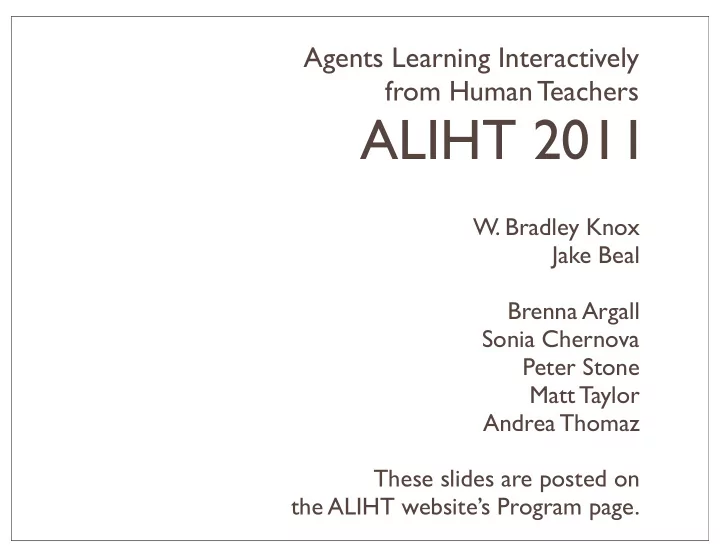

Agents Learning Interactively from Human Teachers ALIHT 2011 W. Bradley Knox Jake Beal Brenna Argall Sonia Chernova Peter Stone Matt Taylor Andrea Thomaz These slides are posted on the ALIHT website’s Program page.
Welcome!
Quick stats • 14 papers • 5 invited talks • Joanna Bryson (University of Bath) • Thomas G. Dietterich (Oregon State) • Ian Fasel (University of Arizona) • Jan Peters (Max-Planck Institute) • Dan Roth (University of Illinois - Urbana Champaign)
Best Presentation Award
Agents Learning Interactively human sees an effect of learning before teaching finishes (t each -> observe learning -> teach) from Human Teachers implies the human considers the student and communicates intentionally
Outline • Why? • Taxonomy • Discussion points/questions
Why? (grounded answers) • Programming for non-programmers • Customization/extension by the end-user • Faster and/or less costly learning • “You don’t know something until you teach it.” • To study how people teach
Why? (speculative answers) • Interaction may build trust and human understanding of the agent • Learning creates social connection • The thrill of teaching • Human-centered AI
From many contributions, sorting it out
Taxonomy Purpose of teaching • Autonomous task completion • Teaching new tasks • Customizing existing task solutions • Improving communication • Learning through teaching
Taxonomy Human-to-agent communication modalities • Demonstration • Reward/punishment • Verbal advice/directions • Curriculum design / Environment shaping • Gestures • Unconstrained interaction • Unintentional signals (e.g., facial expressions)
Taxonomy Agent-to-human communication modalities • Observable behavior • Asking (for help, information, guidance, etc.) • Belief/prediction statements • Emotional expression
Taxonomy Interaction scheme • Iterations between teacher and student • Teacher and student act concurrently
Taxonomy Knowledge representation • Behavior parameters • Value functions • Probabilistic/predictive models • Logical formulas
Taxonomy Learning from multiple sources • Multiple teaching modalities (demonstration and feedback) • Combining with non-teaching information (e.g., MDP reward for reinforcement learning)
Taxonomy Evaluation metrics • Effectiveness - learned performance • Efficiency • Human time • Training cost by performance • User satisfaction
Taxonomy • Purpose of teaching • Human-to-agent communication • Agent-to-human communication • Interaction scheme • Knowledge representation • Learning from multiple sources • Evaluation metrics
Let’s discuss (over the next two days)
Discussion topics Comparative evaluation Interactive algorithms often aren’t compared. But we must evaluate relative strengths to move forward. Standardized challenge task? • room for robots?
Discussion topics Theory What should we try to prove? What assumptions must be made? At what cost to applicability? Perhaps one of our goals should be to provide the correct assumptions.
Discussion topics Gathering/reusing data Ease : Supervised learning > reinforcement learning > learning interactively from a human In what situations can data be reused? Strategies for reducing cost of human data?
Discussion topics Experimental logistics Experiments with authors or colleagues as subjects yield narrower results. But technical academic departments often lack infrastructure for facilitating human studies. Tap our collective experience in creating such infrastructure.
Discussion topics Publishing venues General AI - IJCAI, AAAI Machine learning – ICML, ECML, NIPS, Agents-focused – AAMAS, GECCO, IVA Robots/Interaction – HRI, ICRA, IROS, ROMAN, RSS(?) HCI/Interfaces – IUI, UMAP , CHI, SIGGRAPH(?) Developmental learning – ICDL NLP - ACL, CoNLL, EMNLP , NAACL Journals - TAMD (and many others)
Discussion topics Reviewers ALIHT straddles several areas, and reviewers often come from narrower backgrounds. Strategies for addressing reviewer's biases? (e.g., from the RL community, arguably misplaced standards for theory and extensiveness of experiments and too much lenience on number and source of subjects) At community and individual levels
Discussion topics Fundamentals of ALIHT Is our task to integrate developments from machine learning, psychology, etc.? Or are there fundamental contributions that generalize across the ALIHT subfield? • Biggest bottlenecks? • What can we offer our larger communities? And what can we take from each other?
Proposed discussion topics • Comparative evaluation • Theory • Gathering/reusing data • Experimental logistics • Publishing venues • Reviewers • Fundamentals of ALIHT
Enjoy! (And discuss!)
Recommend
More recommend